...with a tracking platform!?
Over on the "Starry Sky" section, you can read about the destruction of the Meade LXD-55 mount that I used to use to carry the solar rig (among other kits). Over there is also the story of the Sky Watcher Star Adventurer (SWSA) I bought from an eBayer. It is much more capable than I expected, carrying the TMB92SS for deep-sky work without much drama. It also carries the Lunt 60 in both single- and double-stack modes. The first part of the entry below replicates some content from the same dates over in the sidereal reading room. More about sungazing follows.
1/26/2023.
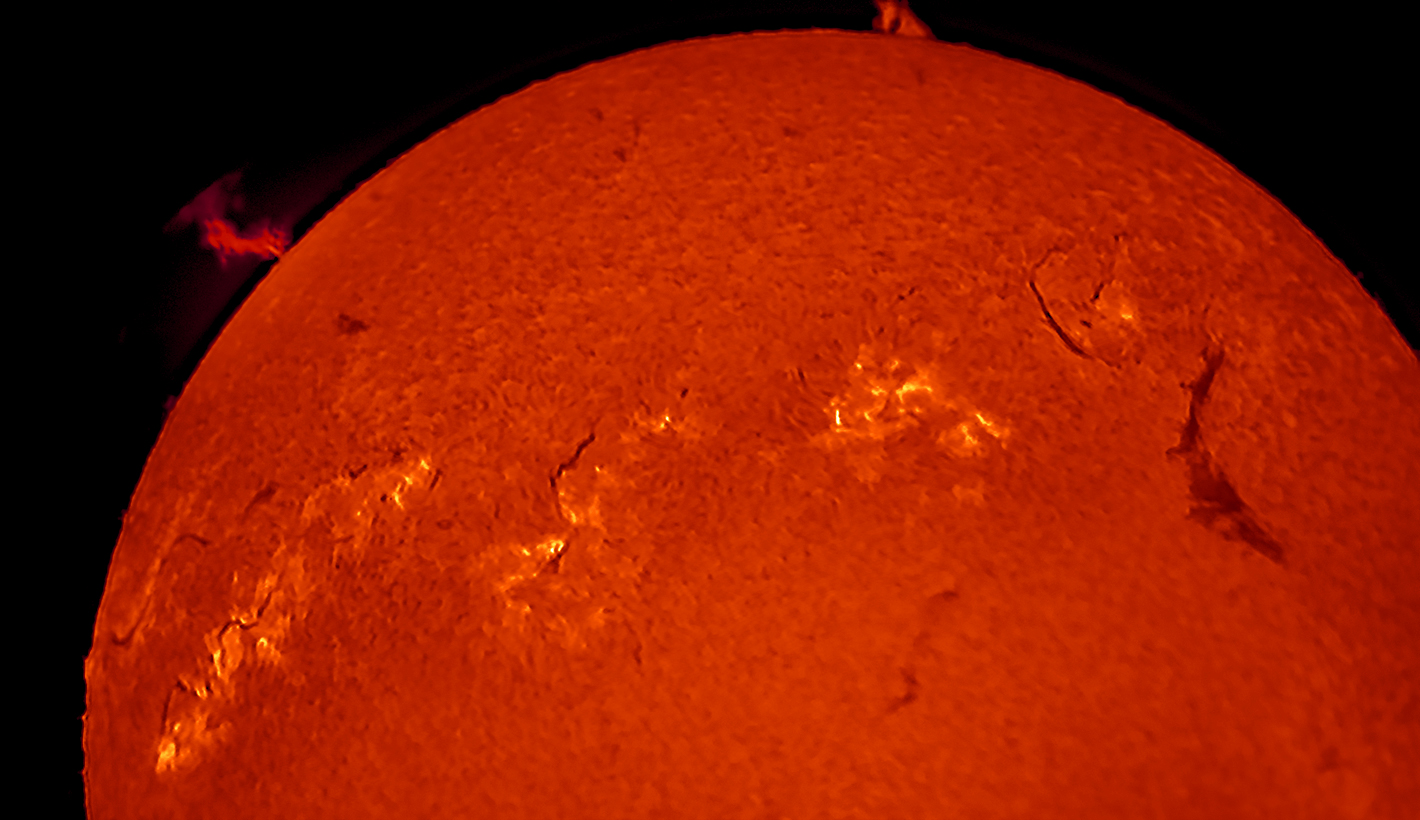
Best 100 of 500
2.66 ms, gain 236
Double-stacked.
That's pretty much the full frame. The Sun measures 2900 pixels and today's Sun subtends 32.5 arc minutes or 1950 arc seconds. That means the image scale is 0.67 arc seconds per pixel on the ASI178MM chip. Ergo, as configured right now, this is a 740mm imaging rig. There's a barlow or telecompressor -- I honestly don't recall which! -- permanently mounted in the 1.25-inch snout I normally use with the ASI178MM and its Newton's rings suppressor. Experiments are yet again in order.
Things did not actually go very well: too much wind rendered life cold and the image very shaky, not enough battery power, too many clouds, dreadful seeing, and not enough patience. At the preview scale above, fine, but it's not what it needs to be. It's a start.
1/27/2023. Less wind, more patience. Without the barlow glued into the solar snout, the perihelion Sun barely fits on the chip. (Try a compressor?) Full-sun imagery really needs two frames. Single-stacked exposures without the barlow can be as short as 200 microseconds at reasonable gain (they can be well under a millisecond with the barlow in place). The difference in mass is significant; the mount is far less prone to undamped bouncing when touched (or breathed upon). I messed some with the tilt of the internal etalon; a decently flat field with decently narrow spectral performance is readily available but does still require some local adjustments (a flat made in post by blurring, inverting, and layering in with soft light comes close but still needs tweaks). I think the anti-Newton's-rings tilt is excessive for this configuration. Take some of that out and see if the lower corners of the frame sharpen up. Focus with gamma set for maximum contrast; image with gamma disabled. Some things remain the same.
Slow motions: the dec fine adjustment is, in a word, fine. For RA adjustment (or a fair approximation thereof) when doing video clips, the azimuth adjustments of the SWSA serve nicely. Having discovered that use of the azimuth screws, I am very glad that there is a William Optics base on the way.
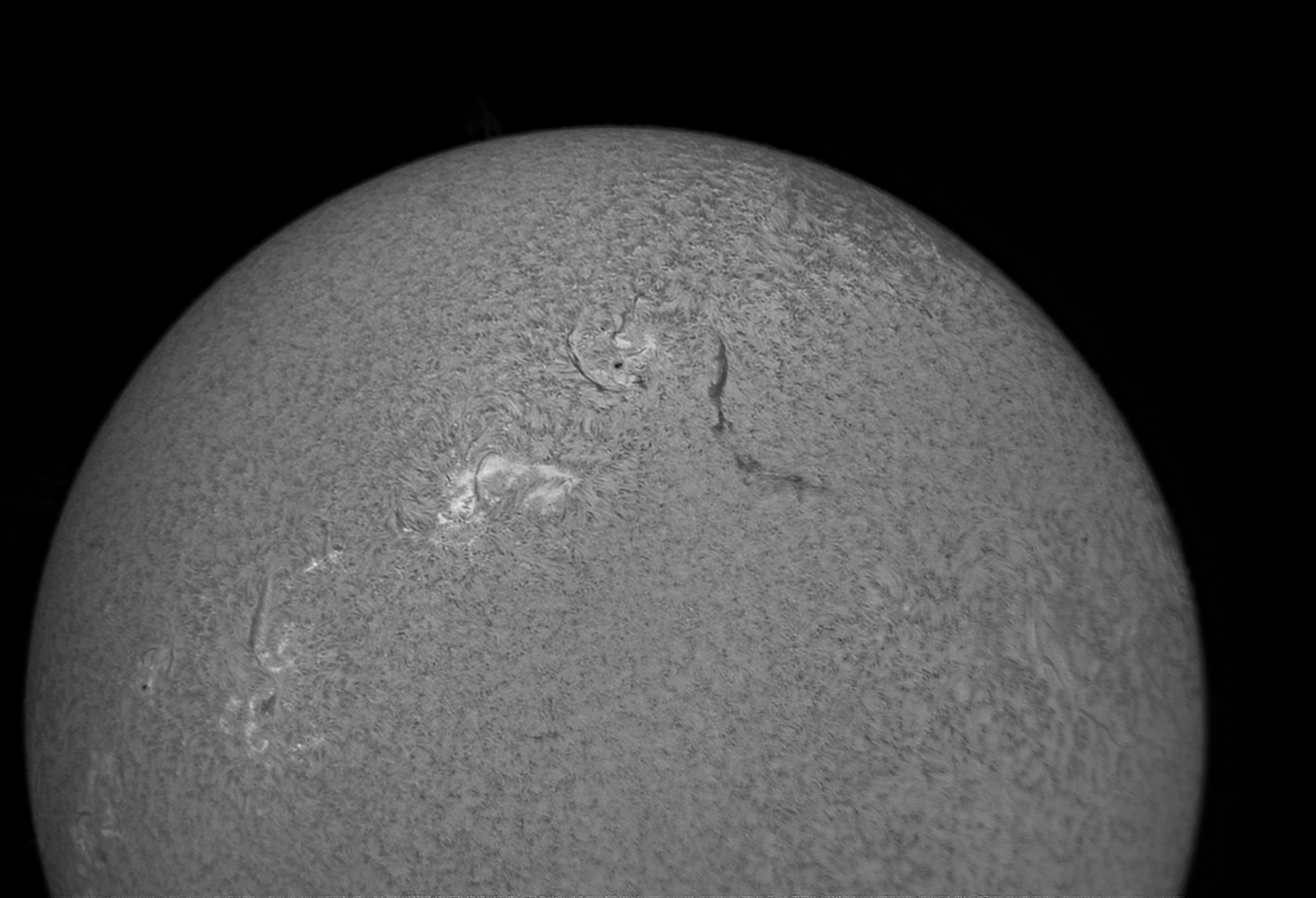
Single-stacked, 200 of 2000 frames
Gamma off, flatfielded in post
Exposures 200 microseconds to fight bad seeing.
For both solar and deep-sky imaging, methods of producing useful flats need to be found. A good flat makes a huge difference. Unfortunately, so does a bad one. Blurring a copy of the frame (Gaussian, 100-150 pixels), inverting the image, and blending with "Soft Light" goes a long way toward flattening in post, but some local fixes are usually needed too.
Later that night... I've removed about half the tilt from the Newton's rings suppressor, and inserted an Antares 0.5x reducer as close to the camera as possible. I just need to find a few percent reduction (sorry, Georgia election joke) to permit single-frame whole-disk photos. Tomorrow, I hope for just that, without Newton's rings, and for sharper focus across more (perhaps all) of the frame. I'm probably asking for too much, but let's find out.
1/28/2023. Good, not yet spectacular results from the shorter EFL. Yes, inserting an Antares 0.5x compressor very close to the sensor does provide a good full-disk view (with some issues) and does not require excessive in-travel to focus. Sharpness across the frame is much improved by the lessened tilt angle and is at least good across the width of solar image. Newton's rings did not appear in either single- or double-stacked mode. On the other hand, getting even illumination is a pain and it looks like there are a couple of factors to be dealt with. The uneven bandpass across the full frame is one, actual occulusion of the optical path owing to the 6mm trim filter (or something else) may be another. The disk has to be in the right place on the chip to get a clean, reasonably well illuminated image. First, get it to work; then make it routine.
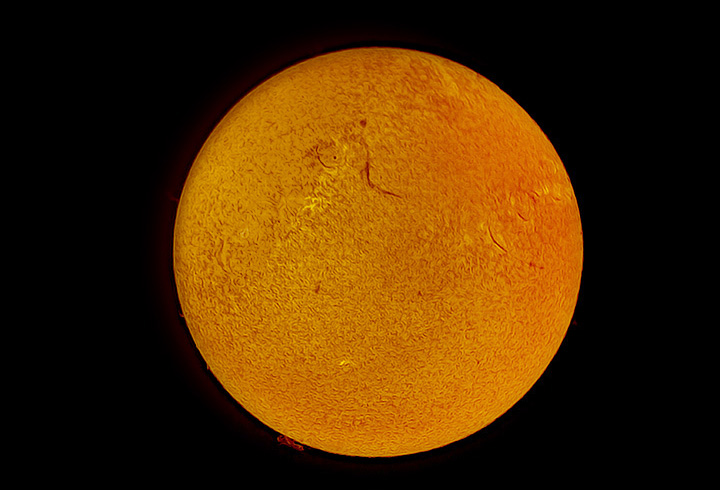
That's coming along. Not there yet, but it's coming.
For these trials, I set up in a small patch of sunlight in one corner of the lawn. Clouds thickened as I worked, and rain will move in overnight or tomorrow, so I wasted no time gathering several sample clips (full disk, ROI, each corner, double-stacked...). All of today's clips were mere "plausibility checks," not pursuits of perfection.
It seems slightly odd to select a R.O.I. with the telecompressor in place, but it's not entirely nonsensical: I'd prefer not to reconfigure too much in the field. I have no real complaints about the result:
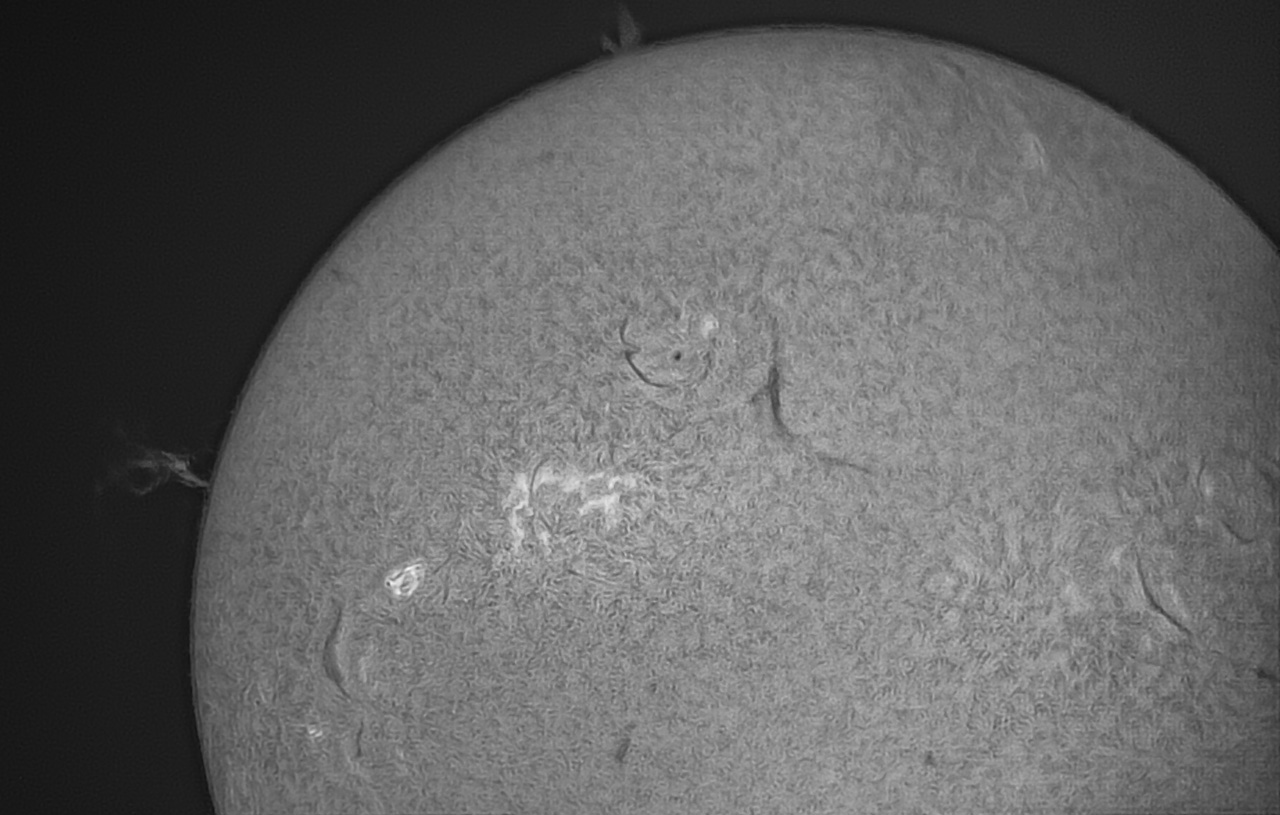
Today's lessons: Full disk is possible, but a Region Of Interest around 2000x1300 works great (and yields close to 100fps). So far, single-stack mode is preferable (more even light, much faster exposures and lower gain). When processing full-disk images in AS!3, analyze the files and set alignment points in "planetary" mode, not "surface."
When next we meet, I hope to have the optical train cleaned up and to have the SWSA imore solidly mounted. (Both done. Agena's included shipping got the William Optics base to me before the tracking even knew it was enroute.)
1/30/2023. I'm pretty much starting over with this kit now that I've seen that a variety of setups can work. After a pretty thorough workout: the William Optics base makes a huge difference in stability for focusing and framing; the tilt-adjuster is apparently not needed in these configurations (go figure); it's probably best to plan on two-frame mosaics for full-disk images (the image scale is better, and without the tilt-adjuster, it's not clear where the 0.5x compressor can be mounted, but of course, I have ideas); it's time to revisit making flats without defocusing (which doesn't work except in long focus configurations). I have cleaned all the surfaces that might matter and gathered some tubes, adapters, barlows and compressors for the next clear day (which may be a while). I've also reversed the D-plate by which the Lunt is mounted for improved balance in single-stacked mode.
2/03/2023. That thin translucent plastic the Post Office wraos around packages in inclement weather makes a decent diffusor for solar imaging. A diffusor made from two layers, neither taut, works fine. Exposures for a single-stacked flat were on the order of 200ms, but that's no problem since just 50 frames seems to be plenty.
I tried the solar kit with no tilt adapter. Two-panel mosaics make things significantly less casual than a single panel full-disk arrangement would allow. I think I can discern Newton's rings in that full-disk grayscale image. They're way down in the noise, but if I squint, I am pretty sure I can see them. So I've reintroduced the tilt-adapter immediately upstream of the sensor which also means there's room for the Antares 0.5x reducer. Mounted so close within the snout, it's more like a 0.92x reducer, but that's fine. Tomorrow is another day.
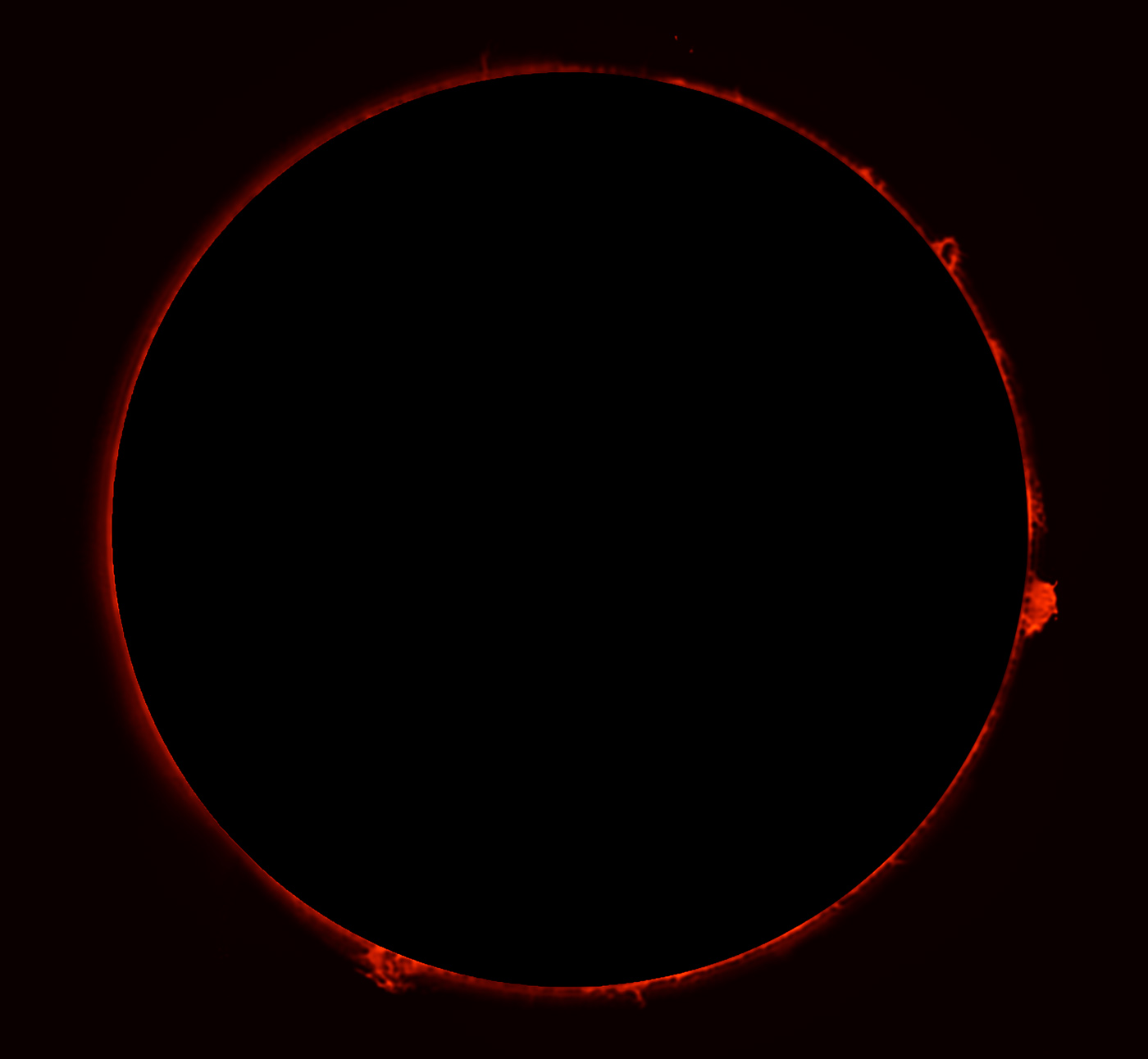
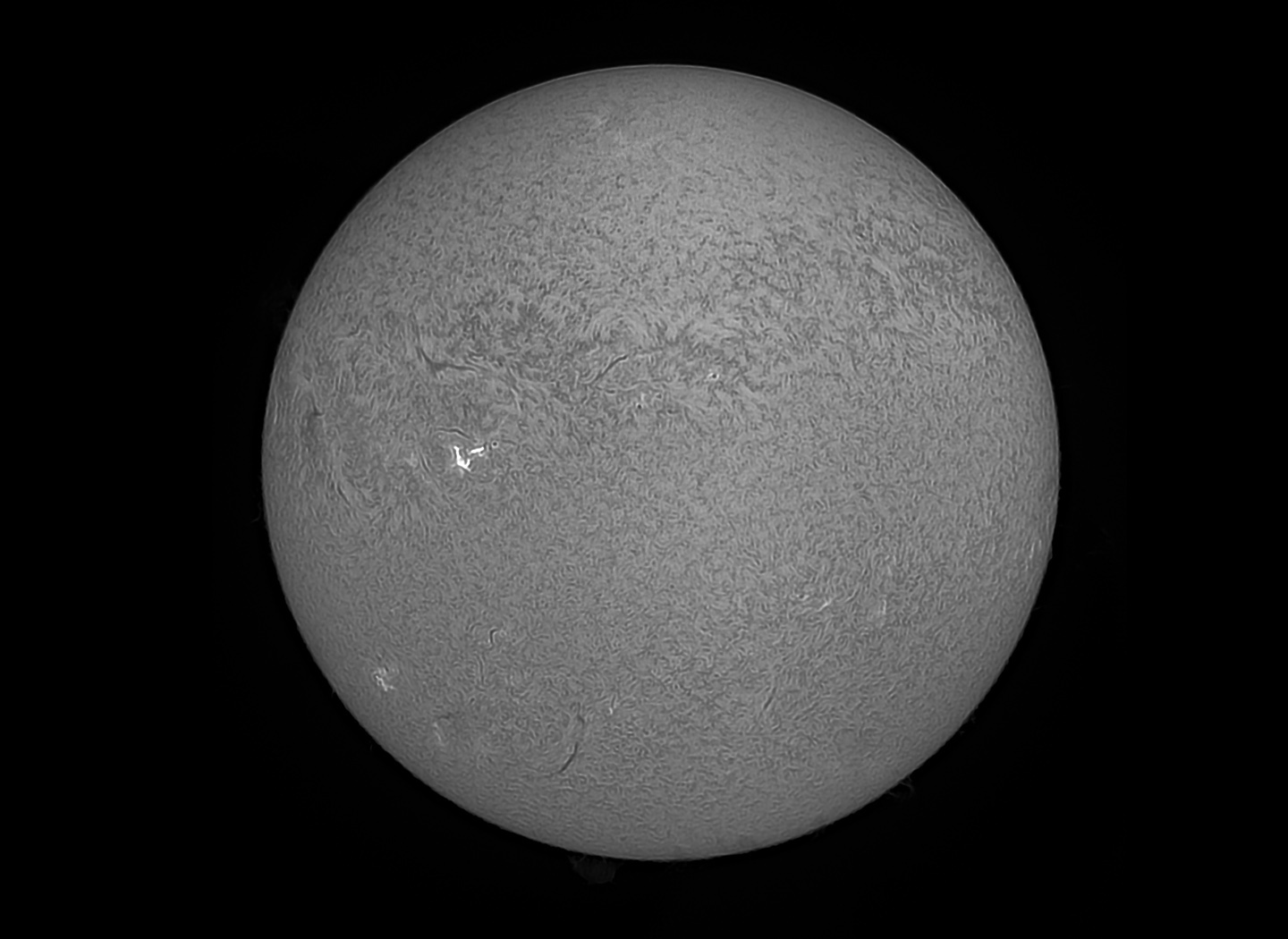
Two panel mosaics, single-stacked. Best 200 of 1,000.
Disk: 0.2ms exposures. Proms: 4ms.
No tilt, no reducer.
2/04/2023. I re-introduced the tilt-adapter with a very modest amount of tilt. That made room to insert the Antares 0.5x compressor just in front of the sensor which makes single-clip whole-disk imaging possible. And I accidentally left the camera in extended bit-depth mode. The on-screen prompt is "12-bit" but the text file written by FireCapture says "14-bit." Either way, the result does have better dynamic range. This is one clip with the histogram-defined transfer function very carefully chosen.
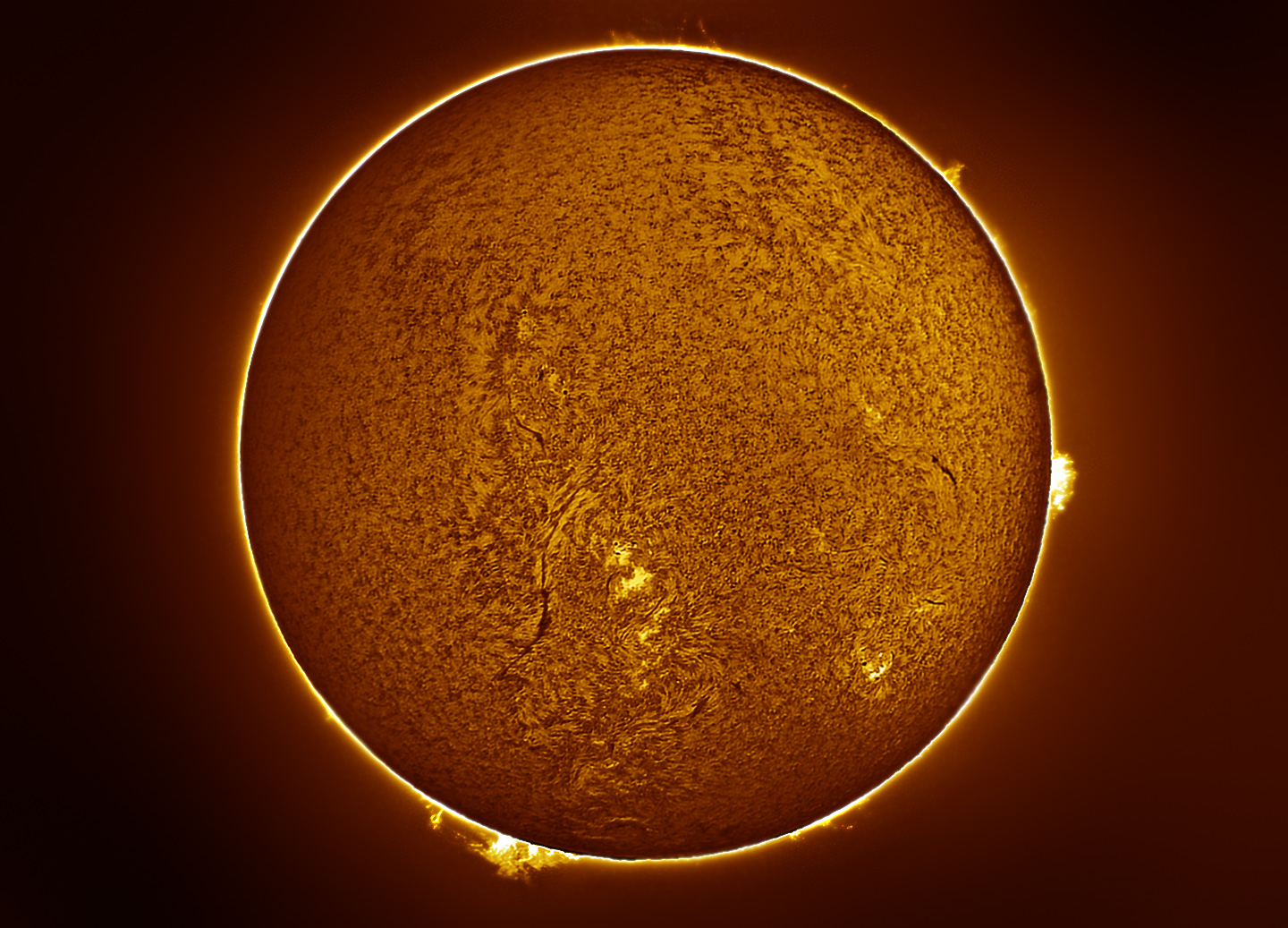
Best 200 of 1,000, single-stack.
Tilt adapter and Antares 0.5x compressor in place.
Flat-fielded (two layers of USPS plastic).
Best 200 of 1,000 frames.
Make it big, sure.
The flat-fielding works; the Newton's rings are gone. Now mess around and find the best orientations and filter settings for the most uniform illumination and filtration.
My deep-sky photos are made with a variety of sensors and optics. Deepest images come now from a ZWO ASI1600MM Cooled Pro CMOS camera, an ASIair (model 1) and sometimes one of several laptops. A good many images come from an unmodded Canon 6D but a lot more will be coming from an R6. Video and video extracts begin in a Canon EOS M, usually running in crop mode via Magic Lantern firmware (but the 6D and especially the R6 will probably see more use). Telescopes include an AT10RC, an Orion 10" F4 Newtonian, and a pair of apochromats: a TMB92SS and a AT65EDQ. A very early Astro-Physics 5" F6 gets some use, too. So do lots of camera lenses on both the ASI1600 and on the Canons. A solar Frankenscope made using a 90mm F10 Orion achromat and the etalon, relay optics, and focuser from a Lunt 60 feeding a small ZWO camera will see more action as the Sun comes back to life (Autostakkart!3 is my current fav for image stacking). Mounts include an iOpton SkyTracker (original model), a bargain LXD-55, a Losmandy G11 (492 Digital Drive), and an Astro-Physics Mach1. PixInsight does most of the heavy lifting; Photoshop polishes. Some of the toys are more or less permanently based in New Mexico. I desperately hope to get back soon.
:: top ::